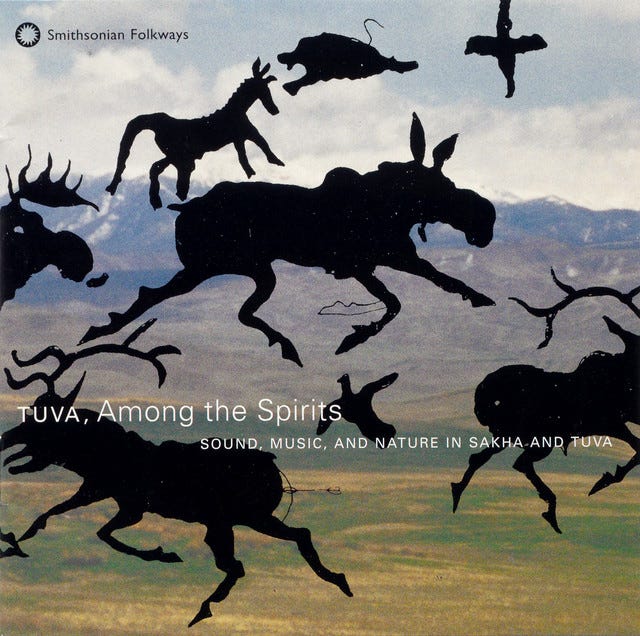Genre of the Day - Sakha Traditional Music
Album of the Day - Tuva, Among the Spirits: Sound, Music and Nature in Sakha and Tuva by Various Artists (1999)
I learned of the word topophilia the other day, and it struck me in regards to the greater understandings of music I seek through this column. The term encompasses a person’s emotional, spiritual, and physical ties to a place. Expressions of topophilia run deeply through the veins of traditional and folk music; through musical visions of local ambience, you can nearly feel your feet on the ground as you absorb the deep love people have for their places. In the Pamir Mountains, it rises as high as the heavens in the vocals of falak singers. It’s in Hmong music’s use of leaves as instruments that carry secrets and poems. Though not technically folk, it’s in the grit and metallic nature of NYC’s drill rap.
Siberia is feared worldwide for its dry, desolate steppes and dismally cold climate. For most people, it seems unfathomable to try to conjure up a deep love for what seems a dismal place. However, a profound appreciation and connection to the immediate surroundings is key in surviving such a treacherous land, and it is expressed beautifully in many Siberian forms of music.
As a case study, the region of Sakha epitomizes the region’s extremes as the largest subdivision of Russia and its coldest. Portraits of life in the capital Yakutsk, considered the coldest major city in the world, have gone viral several times over. The cold is a constant; Sakha singing, on the other hand, is boundlessly complex. Diving into the dense snow of music theory, Sakha singing often features something called mobile scales—slow, gradual changes in tone throughout a piece that don’t follow one grounded tonal center. Sometimes, you don’t need free jazz experimentation; the steppe blesses with a melodic freedom. Tardan yllyyr, a term referring to the way Sakha’s singers imbue each syllable with melismatic decoration, is another reflection of its musical vastness in addition to the renowned overtone and throat singing across Siberian traditions. The khomus jaw harp is king, a fascinating tiny instrument with atmosphere-filling strength.
Today’s album threw me for a bit of a loop initially, as it combines traditional tunes from both Sakha and the southern region of Tuva. I initially assumed they were neighbors, but as I researched, Russia’s sheer size laughed in my face as I discovered they lie nearly 1,500 miles apart. The album then acts as a worthy subversion of our expectations and proves the looseness of genre: in including traditions from two interrelated but separate regions, we understand music for the flowing continuum it is. The land in both regions is quite similar, so one might observe similar undercurrents of topophilia among the diverse array of musical styles featured. These are soft, ambient field recordings captured by rivers, in wide grasslands, standing by running horses, a labor of love and place. Song titles affirm the primacy of nature; jaw harps and singing often aim to imitate the noises of animals, a stunning manifestation of the region’s shamanistic traditions that place great importance upon animals in spiritual and daily life, a cross-continental tie to many indigenous cultures of North America. These recordings evoke a Sakha summer, brimming with deep gratefulness for warmth, flowing rivers, and the freedom those surroundings lend people and creatures through vocal expression that runs as deep and cavernous as men’s throat singing performances and celestially-directed coos on “The Legacy of Ancestors.”






My only knowledge of the music of Tuva was via the band Huun-Huur-Tu. I noticed some throat singing in the album you link, and am intrigued to learn how Sakha singing and throat singing interwieve (if they do).
I got to see Huun-Huur-Tu perform live at the WOMAD festival in Seattle in 2000. In fact, I got to smoke a joint with the guys in the band backstage! I was an event videographer at the time and filmed the artists (did not film that moment though!). Got to film interviews with a ton of amazing musicians, including Peter Gabriel.